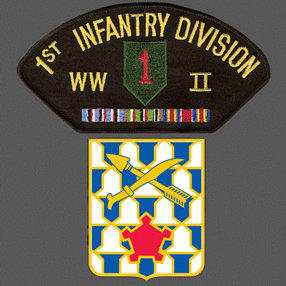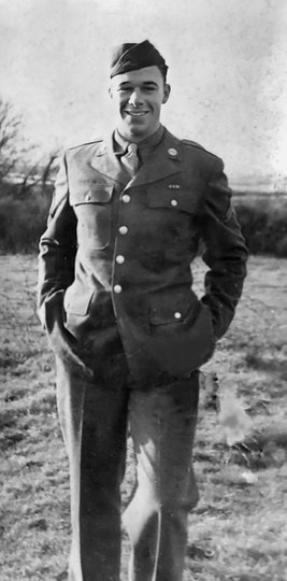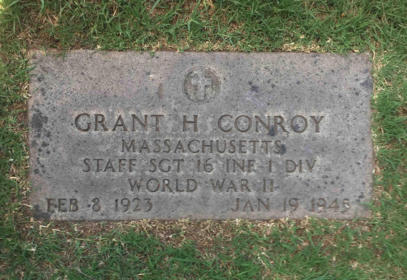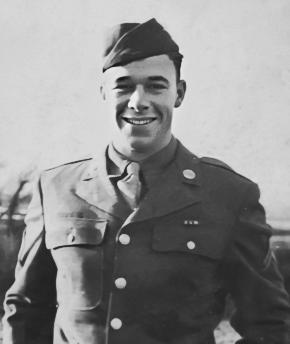
copyright © Wartime Heritage Association 2012-2024
Website hosting courtesy of Register.com - a web.com company
Wartime Heritage
ASSOCIATION
Remembering World War II
Name:
Grant Harding Conroy
Rank:
Staff Sergeant
Service Number:
11053594
Service:
Company K, 16th Infantry Regiment,
1st Infantry Division, US Army
Awards:
Purple Heart
Date of Birth:
February 8, 1922
Place of Birth:
Brookline, Norfolk Co., Massachusetts
Date of Enlistment:
June 16, 1942
Place of Enlistment:
Boston, Massachusetts
Address at Enlistment:
Weston, Middlesex Co., Massachusetts
Age at Enlistment:
20
Height:
5 feet, 11 inches
Occupation:
Machinist
Marital Status:
Single
Date of Death:
January 18, 1945
Age:
22
Cemetery:
Mountain View Cemetery, Altadena, Los Angeles County, California
Grant Harding Conroy was the son of Emmett Gordon Conroy (1887-
1959) and Ethel Frances (Howse) Conroy (1882-1966). His father was
born in Biddeford, York County, Maine. His mother was born in
Bridgetown, Annapolis County, Nova Scotia. He had an older brother
Lincoln Gordon Conroy (1914-1978).
Grant was born in Brookline in Norfolk County, Massachusetts. In
1930, the family lived on Viaduct Street in Sharon, Norfolk Co. By
1940, the family was on Orchard Avenue in Weston in Norfolk Co.
Grant’s brother Lincoln was worked as a Ship Fitter at the California
Shipbuilding Corporation in 1940 in Los Angeles and also served in the
US Navy (dates unknown).
After enlistment in June of 1942, Grant was assigned to Company K of
the 16th Infantry Regiment, 1st Infantry Division, US Army. During
World War II, the regiment ‘lit the torch’ in North Africa in 1942 and
landed as part of Operation Torch and was part of “Operation Husky,”
the Allied invasion of Sicily. On June 6, 1944, the 16th Infantry was
one of the regiments ordered to take Omaha Beach during “Operation
Overlord”, D-Day. Of the five D-Day landing beaches, Omaha Beach
was the deadliest—survivors dubbed it “Bloody Omaha.” Hundreds of
the regiment’s young infantrymen were mowed down, but by noon,
the 16th had established a beachhead and seized the town of
Colleville-sur-Mer.
At the end of 1944, after sustaining very heavy casualties from enemy artillery fire and the cold dreary
weather in the Stolberg Corridor, the entire 1st Infantry Division was sent to a rest camp on December 12,
1944. The stay was short, because Hitler launched Operation Wacht am Rhein later referred to as Operation,
four days later and the Battle of the Bulge was on. The division was sent to bolster the northern shoulder of
the bulge near Camp Elsenborn. The 16th Infantry was ordered to positions near Robertville and Waywertz,
Belgium. For the next month, the men of the 16th Infantry held defensive positions there, conducted heavy
patrolling toward the German positions near Faymonville, and engaged in a number of firefights with troops
of the 1st SS Panzer and 3rd Fallshirmjaeger Divisions. All of this was conducted in heavy snows during one of
the coldest European winters on record.
On January 15, 1945, the Big Red One (1st Division) launched
its part of the Allied counteroffensive to reduce the Bulge.
Staff Sergeant Grant Harding Conroy was killed in action on
January 18, 1945 at the age of 22 during the Battle of the
Bulge. He was initially interred in Europe, and is now buried in
Mountain View Cemetery and Mausoleum in Altadena, Los
Angeles County, California.
He is also remembered on the First Division Memorial, in
Bütgenbach-Büllingen, Belgium; a tall grey granite obelisk
commemorating by name all of the First Infantry Division
soldiers killed while fighting in the area. The memorial
commemorates the 458 Big Red One soldiers killed between
December 16 and February 7, 1944.
Grant Harding Conroy









- World War I - Menu
- WWI Stories and Articles
- Photos - Yarmouth Soldiers
- Selection of World War I Songs
- WWI Casualties of Yarmouth, NS
- Those Who Served - Yarmouth, NS
- WWI Casualties Digby Co. NS
- WWI Casualties Shelburne Co. NS
- Merchant Mariners (1915) Yarmouth, NS
- Canadian Forestry Corps - Non Yarmouth Birth/Residence Enlistments
- US Draft Registry - Yarmouth NS Born


- World War II - Menu
- WWII Stories and Articles
- Telegraphist Air Gunners
- WWII Casualties of Nova Scotia
- US Casualties with NS Connection
- Far East/Pacific Casualties with NS Connection
- Merchant Navy Casualties Nova Scotia
- Nova Scotia WWII Casualties Holten Canadian War Cemetery
- D-Day Casualties - Nova Scotia
- CANLOAN Program Casulaties - Nova Scotia
- Battle of the Bulge Casualties - Nova Scotia
- WWII Casualties Yarmouth NS
- Yarmouth Casualties - RCAF RAF Canadian Army WWII
- Yarmouth Co., Marrages WWII
- Casualties Non-Born/Residents with Connection to Yarmouth Co., Nova Scotia.
- WWII Casualties Digby Co., NS
- Non-Nova Scotian WWII Casualties Buried in Nova Scotia
- WWII RCAF Casualties Aged 16-18
- Brothers/Sisters Who Served - World War II













